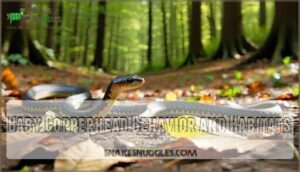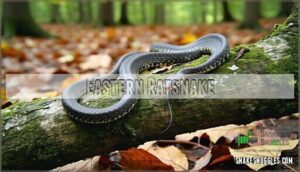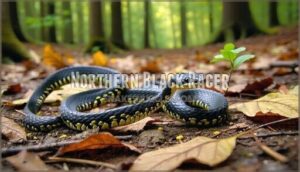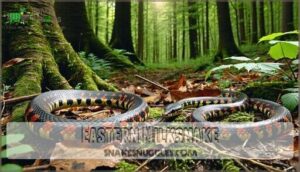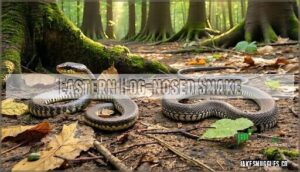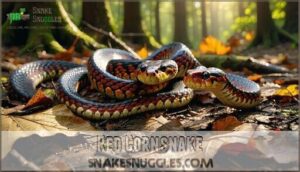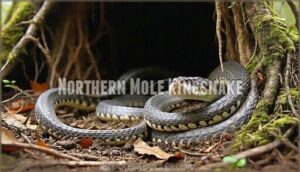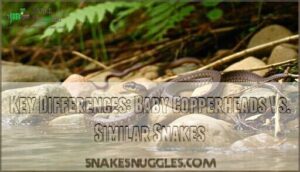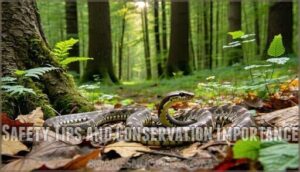This site is supported by our readers. We may earn a commission, at no cost to you, if you purchase through links.
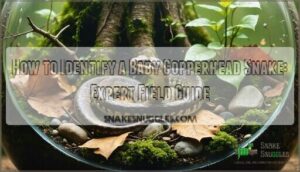 Last spring, a homeowner near Raleigh posted a photo of what she thought was a “baby rattlesnake” in her garden—the brown hourglass markings seemed unmistakable. Within hours, a local herpetologist identified it as a juvenile Eastern Ratsnake, a harmless species that mimics the copperhead’s pattern almost perfectly.
Last spring, a homeowner near Raleigh posted a photo of what she thought was a “baby rattlesnake” in her garden—the brown hourglass markings seemed unmistakable. Within hours, a local herpetologist identified it as a juvenile Eastern Ratsnake, a harmless species that mimics the copperhead’s pattern almost perfectly.
This misidentification happens more often than you’d think, and the stakes aren’t trivial. Baby copperheads, though rarely aggressive, possess venom from birth and often go unrecognized because their juvenile features differ subtly from adults.
Knowing what separates a true copperhead from its harmless doppelgängers requires understanding specific physical markers—head shape, scale texture, tail coloration, and banding patterns—that remain consistent even in snakes barely longer than a pencil.
Table Of Contents
- Key Takeaways
- How to Identify a Baby Copperhead Snake
- Baby Copperhead Behavior and Habitats
- Species Commonly Confused With Baby Copperheads
- Key Differences: Baby Copperheads Vs. Similar Snakes
- Safety Tips and Conservation Importance
- Frequently Asked Questions (FAQs)
- How do you know if a Copperhead is a baby snake?
- What do Baby Copperheads look like?
- What do copperhead snakes look like?
- How to identify venomous baby Copperheads?
- Why are baby copperhead snakes different from adult Copperheads?
- How do you identify a Copperhead?
- Are Baby Copperhead Snakes Active During the Day or Night?
- How Far Away Should I Be When Attempting to Remove a Baby Copperhead?
- What is the Average Lifespan of a Copperhead?
- Are There Any Natural Predators of Baby Copperhead Snakes?
- Conclusion
Key Takeaways
- Baby copperheads are identified by their distinctive hourglass-shaped crossbands (wider at the sides, narrower at the spine), triangular copper-colored heads with vertical pupils and heat-sensing pits, and a bright sulfur-yellow tail tip that fades by age three—features that distinguish them from harmless look-alikes like ratsnakes, racers, and watersnakes.
- Common misidentification occurs with juvenile Eastern Ratsnakes, Northern Watersnakes, and Eastern Milksnakes, all of which have blotched or saddle patterns that differ from the copperhead’s hourglass bands and lack the spear-shaped head, keeled scales, and facial heat pits characteristic of venomous pit vipers.
- If you encounter a baby copperhead, maintain at least six feet of distance, avoid sudden movements, and never attempt DIY removal—contact wildlife professionals instead, as most bites occur from accidental contact rather than aggression.
- Copperheads play a critical ecological role by controlling over 70% of rodent pests in forested areas and serving as intermediate predators that stabilize biodiversity, making their conservation essential for ecosystem balance despite their venomous nature.
How to Identify a Baby Copperhead Snake
Identifying a baby copperhead requires attention to several distinctive features that set them apart from harmless look-alikes. You’ll need to examine specific physical characteristics, color patterns, and anatomical details to make an accurate identification from a safe distance.
The following guide breaks down the key markers you should look for in the field.
Key Physical Features
When you’re face-to-face with a baby copperhead, a few unmistakable physical traits will tell you exactly what you’re looking at—but you’ll need to know where to look first. Start with the head: it’s distinctly spear-shaped and wider than the neck, designed to house venom glands.
You’ll notice keeled scales with raised ridges running along the body, giving the snake a rough texture rather than the smooth appearance of non-venomous species.
Distinctive Color Patterns
The hourglass pattern is the copperhead’s calling card—those distinctive dark brown or reddish-brown crossbands are wider at the top and bottom of the body, cinching narrow in the middle, and you won’t find this exact arrangement on any harmless snake in their range.
The coppery-tan base color blends with leaf litter, creating natural snake camouflage that makes juvenile copperheads nearly invisible on forest floors.
These pattern variations stay consistent across baby copperheads, though hue shifts from lighter copper to deeper russet can occur depending on the individual.
Head and Eye Characteristics
Beyond pattern recognition, a baby copperhead’s head and eyes reveal features that no look-alike species can replicate—starting with that unmistakable triangular head shape, wider than the neck to accommodate venom glands, and topped with a warm copper hue that gives these pit vipers their name.
You’ll notice vertical pupils—a hallmark of venomous snake species—set against pale gold irises, creating a striking contrast with the dark, elliptical eye shape. The keeled scales give the head a textured appearance, and between each eye and nostril sits a heat-sensing pit, the defining characteristic of any pitviper used for detecting warm-blooded prey in low-light conditions.
Tail Color in Juveniles
One of the most reliable markers you’ll spot on a baby copperhead—and one that vanishes with age—is that bright sulfur-yellow or lime-green tail tip, used like a tiny lure to attract frogs, lizards, and other small prey right into striking range.
Baby copperheads have a bright yellow tail tip that works like bait to lure prey within striking distance
This yellow tail fades gradually as juvenile copperheads mature, usually disappearing by age three or four, making it an excellent diagnostic feature for distinguishing young specimens from adults during snake identification in the field.
Baby Copperhead Behavior and Habitats
Understanding where and how baby copperheads live helps you know where to watch your step. Their behavior changes with the seasons, and recognizing their defensive postures can keep you safe.
Let’s look at the key habitats, activity patterns, and warning signs you should know.
Typical Habitats and Regions
Baby copperheads are found across 28 U.S. states in the Eastern region of North America, from Massachusetts to Texas. Their geographic range showcases remarkable regional adaptation, with populations thriving in diverse environments, from Connecticut’s traprock ridges to the Chihuahuan Desert’s riparian corridors.
Understanding copperhead habitat preferences is crucial for knowing where to watch your step:
- Deciduous woodlands with rocky outcrops, leaf litter, and fallen logs provide ideal cover and hunting grounds
- Ecotones and forest edges where meadows meet marshes or streams offer abundant prey and shelter
- South-facing rocky slopes create warm microclimates perfect for basking and denning sites
- Wetland margins in southern states, including swampy regions and lake edges, support healthy populations
- Urban environments like suburban yards, abandoned buildings, and debris piles show their adaptability to human-altered landscapes
This copperhead snake habitat and behavior pattern demonstrates exceptional wildlife habitat flexibility, though roads and quarrying threaten some isolated populations. Copperheads are commonly found in areas with copperhead species that are well adapted to their environments.
Activity Patterns and Seasonal Behavior
Timing is critical for understanding copperhead snake behavior and avoiding unwelcome encounters. Baby copperheads display distinct activity peaks tied to temperature, season, and developmental needs, making their movements predictable once you know the patterns. Understanding their copperhead activity is vital for avoiding encounters.
| Season | Activity Pattern | Peak Times |
|---|---|---|
| Spring (April–May) | Diurnal, post-brumation emergence | Midday warming periods |
| Summer (June–August) | Crepuscular to nocturnal | Late afternoon through evening |
| Autumn (August–October) | Bimodal, mating-related increases | Dawn and dusk |
| Winter (November–March) | Brumation with brief warm-day activity | Occasional midday emergence |
Daily movement for juveniles increases dramatically after shedding events—from roughly 5 meters to over 34 meters within days. This surge reflects improved sensory function and hunting efficiency. Thermal regulation drives much of their habitat selection, with babies seeking microhabitats offering 23–31°C through basking or retreating to shaded refuges during temperature extremes.
Seasonal migration between denning sites and foraging areas peaks during spring dispersal and autumn returns, when vulnerability to predation and road mortality rises sharply for young venomous snake species moving through unfamiliar terrain.
Defensive Behaviors and Warning Signs
When cornered or startled, baby copperheads shift from cryptic stillness into a repertoire of defensive signals that escalate with perceived threat level. Initial warning signs include rapid tail vibration—mimicking rattlesnake behavior—and a flattened defensive posture that widens their body profile.
If you approach closer, they’ll coil tightly with their head drawn back in an S-curve, positioning for venom delivery should attack avoidance fail. These venomous snake species rarely strike without warning, making recognition of these defensive behaviors critical for safe snake identification.
Species Commonly Confused With Baby Copperheads
Many harmless snakes share the copperhead’s earth-toned palette and banded patterns, leading to frequent misidentifications in the field. You’ll encounter several non-venomous species that mimic the copperhead’s general appearance, especially during their juvenile stages.
Learning these look-alikes will help you distinguish true copperheads from their harmless counterparts with confidence.
Eastern Ratsnake
Juvenile Eastern Ratsnakes are among the most commonly misidentified species in snake identification. These non-venomous constrictors share overlapping habitat selection with copperheads throughout eastern regions, but several key features separate them. Pay attention to these differences for accurate species differentiation:
- Pattern placement – Gray or brown blotches appear only on the back, never extending to the sides as copperhead hourglasses do
- Pattern evolution – The blotched pattern fades completely as ratsnakes mature to solid black within a few years
- Urban encounters – Eastern Ratsnakes frequently seek winter shelter in attics, crawlspaces, and basements, behavior copperheads don’t exhibit
- Conservation status – Both species play essential roles in wildlife ecology and ratsnake diet focuses heavily on rodent control
Understanding these distinctions improves reptile identification skills and bolsters appropriate conservation responses during snake migration periods.
Northern Black Racer
Baby Northern Black Racers present a classic copperhead test scenario—they’re born with pronounced blotches that vanish as black coloration takes over within two years. Unlike copperheads, these non-venomous racers don’t seek winter shelter in your home and become active earlier in spring than venomous species.
Their habitat preferences overlap considerably with copperheads across eastern states, making snake species identification critical during racer behavior observation. Understanding snake migration patterns and seasonal activity peaks strengthens your venomous snake safety skills during field encounters.
Northern Watersnake
Northern Watersnakes hang near water sources and rarely stray far from aquatic habitats, yet their saddled banding sparks endless copperhead confusion. You’ll notice their pattern variations—bands wider at the backbone—differ from the distinctive hourglass shape of venomous snake species.
Understanding these pattern variations and habitat preferences sharpens your snake identification and safety skills, especially since watersnakes exhibit defensive snake behavior when cornered but lack venom entirely.
Eastern Milksnake
Eastern Milksnakes sport saddleback patterns that trick countless observers into mistaking them for venomous lookalikes. You’ll spot red or brown bands outlined in black—quite different from a copperhead’s hourglass—yet panic often strikes before careful observation. These non-venomous residents of fields and forests serve essential snake conservation roles:
- Control rodent populations in agricultural areas
- Display saddle-shaped bands outlined in black
- Range widely across the Eastern U.S.
- Coexist peacefully where copperheads live
- Require careful pattern analysis for correct species classification and taxonomy
Understanding milksnake behavior and habitat preferences sharpens your snake identification and safety skills, especially in overlap zones where species coexistence creates identification challenges.
Eastern Hog-nosed Snake
Among snakes frequently confused with copperheads, the Eastern Hog-nosed Snake presents distinctive defensive behaviors that aid in snake identification. When threatened, this non-venomous species flattens its neck, hisses dramatically, and may even feign death—behaviors absent in copperhead snake identification.
Despite habitat destruction pressures affecting wildlife ecology, these reptiles persist across varied landscapes, contributing to snake conservation efforts through venom research and reptile behavior studies supporting species classification.
| Feature | Eastern Hognosed Snake | Baby Copperhead |
|---|---|---|
| Defense Display | Flattens neck, plays dead | Tail vibration, coiling |
| Snout Shape | Upturned, shovel-like | Rounded, typical pit viper |
| Pattern Boldness | Variable blotches | Distinct hourglass bands |
Understanding snake characteristics and patterns protects both you and these ecologically valuable species.
Red Cornsnake
Red Cornsnakes often share habitat selection with copperheads across the southeastern United States, but their snake morphology differs markedly.
Juvenile cornsnakes display reddish-brown saddle patterns outlined in black—distinct from copperhead hourglass bands. Their rounded pupils and lack of heat-sensing pits confirm non-venomous status.
Understanding these snake characteristics prevents misidentification of venomous snake species, especially as color variation and breeding patterns create regional differences in corn snake appearance affecting snake identification accuracy.
Northern Mole Kingsnake
Lampropeltis calligaster rhombomaculata prefers subterranean environments, which explains its infrequent encounters despite overlapping with Eastern Copperheads. These pale gray to brown serpents utilize sophisticated burrowing techniques to access underground prey, exhibiting venom resistance that facilitates predation on pit viper species.
You’ll notice their blotched pattern differs fundamentally from copperhead hourglass bands—their dorsal spots remain rectangular, not constricted laterally.
Understanding kingsnake behavior and habitat conservation priorities improves snake identification accuracy, reducing needless concern during snake migration periods when surface activity temporarily increases for both venomous snake species and harmless fossorial specialists.
Key Differences: Baby Copperheads Vs. Similar Snakes
When you’re trying to tell a baby copperhead from a harmless lookalike, knowing what to watch for can save you a lot of worry. The differences might seem subtle at first, but once you know where to look, they become clear markers you can spot from a safe distance.
Let’s break down the key features that set baby copperheads apart from the species that are often mistaken for them.
Head Shape and Size
One of the most reliable ways to distinguish a baby copperhead from harmless look-alikes is by examining the head’s distinctive shape and proportions. Baby copperheads, like all pit vipers, have distinctly triangular heads that are noticeably wider than their necks—a spearhead shape caused by enlarged venom glands. Eastern Copperheads display this characteristic coppery color on their crown, which contrasts sharply with the narrow-headed profile of non-venomous snake species.
| Feature | Baby Copperhead | Non-Venomous Look-alikes |
|---|---|---|
| Head Shape | Triangular, spear-shaped, wider than neck | Narrow, tapered, continuous with body |
| Head Width | Distinctly broad due to venom gland size | Slender, proportional to body width |
| Color | Coppery tan to reddish-brown | Variable (gray, brown, black) |
| Neck Distinction | Clear separation between head and neck | Gradual taper, less defined |
| Scalation Patterns | Large symmetrical scales on crown | Smaller, more numerous head scales |
When identifying venomous snakes from a safe distance, you’ll notice this pronounced head structure immediately sets pit vipers apart from species like ratsnakes or racers.
Coloration and Banding Patterns
Perhaps nothing separates a baby copperhead from its harmless mimics more clearly than the signature hourglass pattern—a series of dark chestnut or reddish-brown crossbands that pinch narrow at the spine and flare wide along the flanks, creating the unmistakable silhouette of twin hourglasses stacked end to end. These hourglass bands often don’t meet completely at the spine, appearing broken or offset. The base color—pale tan to pinkish-brown—provides natural reptile camouflage against leaf litter, while the darker crossbands never form complete rings around the body like you’ll see in watersnakes or kingsnakes.
| Feature | Baby Copperhead | Non-Venomous Look-alikes |
|---|---|---|
| Band Shape | Hourglass: wide at sides, narrow at spine | Blotches, saddles, or complete rings |
| Band Connection | Often broken or offset dorsally | Usually continuous or clearly separated |
| Base Color | Pale tan, pinkish-brown, coppery | Gray, brown, black, or reddish |
| Pattern Contrast | Moderate: chestnut to reddish-brown | Variable: high contrast or fading blotches |
| Belly Pattern | Crossbands visible on sides only | Often extends with separate belly markings |
When identifying venomous snakes, focus on these copperhead markings from a safe distance—the hourglass bands distinguish Eastern Copperheads from every other venomous snake species in their range.
Tail Tip Coloration
The most telltale clue in a baby copperhead’s arsenal isn’t the hourglass bands or triangular head—it’s the sulfur-yellow tail tip that glows like a tiny warning beacon against the forest floor. This bright yellow tip acts as a lure, wiggling like a caterpillar to attract frogs and lizards within striking range. Eastern Copperheads lose this vibrant tail color as they mature, generally fading by age three or four—making it your clearest field mark for distinguishing juvenile copperheads from similarly patterned non-venomous species.
| Feature | Baby Copperhead | Adult Copperhead |
|---|---|---|
| Tail Tip Color | Bright sulfur-yellow or greenish-yellow | Copper, brown, or gray (faded) |
| Fading Timeline | Vivid until 3-4 years old | Completely faded by maturity |
| Functional Purpose | Caudal luring: attracts prey | No luring behavior |
When you’re doing snake identification in copperhead territory, check the tail first—that yellow tip confirms you’re looking at a venomous species, not a harmless mimic.
Pupil and Eye Shape
If you’ve ever heard the old rule "vertical pupils mean venomous," you’re onto something—but only pit vipers like copperheads follow it reliably in North America. Baby copperheads have elliptical pupils—like a cat’s eye—set against pale gold or copper-colored irises that shimmer even in low light. This eye structure helps distinguish venomous snake species from harmless lookalikes with round pupils, though you’ll need to get closer than most field guides recommend for safe snake identification.
| Feature | Baby Copperhead | Non-Venomous Lookalikes |
|---|---|---|
| Pupil Shape | Vertical, elliptical | Round |
| Iris Color | Pale gold to copper | Variable (brown, gray, black) |
| Eye Structure | Heat-sensing pit visible near eye | No facial pits |
| Identification Value | Diagnostic for venomous snakes | Requires closer approach |
Safety Tips and Conservation Importance
Knowing how to respond safely when you encounter a baby copperhead can prevent unnecessary conflict and protect both you and the snake. Understanding their ecological value also helps shift perspective from fear to appreciation.
Let’s cover practical safety measures and why these snakes deserve our respect and protection.
What to Do if You Encounter One
When you spot a baby copperhead, your best move is to freeze, take a slow breath, and back away without sudden movements. These venomous snake species aren’t aggressive, but sudden gestures trigger their defensive instincts.
Follow these encounter protocols:
- Maintain at least six feet of distance from the copperhead
- Never attempt hands-on safe removal methods yourself
- Contact wildlife control professionals for relocation assistance
- Keep pets and children away until the snake retreats naturally
Remember, copperhead deterrents work better than confrontation for snake safety.
Preventing Snake Bites
Most copperhead bites happen not because the snake attacks, but because someone accidentally steps on or reaches near one—making smart habits your strongest defense.
Follow these outdoor safety tips to reduce risk around venomous snake species:
| Prevention Strategy | Why It Works | When to Apply |
|---|---|---|
| Wear closed-toe boots in tall grass | Protects ankles where most venomous snake bites occur | Hiking, yard work, camping |
| Use flashlight at night | Reveals copperhead camouflage patterns | Dusk to dawn activities |
| Check before reaching into brush | Avoids triggering defensive venomous snake behavior | Gardening, wood gathering |
| Keep yards clear of debris | Eliminates hiding spots preferred by copperheads | Year-round property maintenance |
Establishing emergency response plans and practicing wildlife encounter protocols ensures you’re prepared if snake bite prevention measures fail.
Copperheads’ Role in The Ecosystem
Beyond bite prevention, understanding copperheads’ contributions to ecosystem balance reveals why reptile conservation matters.
Your local copperhead population controls over 70% of rodent pests in forested areas, preventing crop damage while cycling nutrients through soil as they forage across 30-meter ranges.
As intermediate predators linking mice to raptors, these venomous snake species stabilize biodiversity and signal habitat quality—making their presence an indicator of ecological stability worth protecting.
Ethical Wildlife Observation and Conservation
Protecting these ecological allies starts with observing them on their own terms—keeping your distance, never touching wild specimens, and resisting the urge to relocate snakes you find near your home. Conservation ethics demand we embrace sustainable coexistence through:
- Documenting sightings for wildlife management databases
- Educating neighbors about reptile conservation benefits
- Supporting habitat corridors that maintain ecosystem balance
- Practicing responsible tourism in snake-prone areas
Environmental stewardship means recognizing that venomous snake species deserve protection, not persecution—a principle central to conservation biology and lasting wildlife preservation.
Frequently Asked Questions (FAQs)
How do you know if a Copperhead is a baby snake?
Look closely at the size—baby copperheads measure six to nine inches at birth, far smaller than adults.
Their distinctive sulfur-yellow tail tip, used to lure prey, confirms their juvenile status. This bright coloration disappears gradually as the snake matures into adulthood.
What do Baby Copperheads look like?
Baby copperheads display striking hourglass-shaped crossbands in dark chestnut or reddish-brown against a pale tan base color. You’ll notice their coppery head, vertical pupils, heat-sensing facial pits, and a distinctive sulfur-yellow tail tip they use as a lure.
What do copperhead snakes look like?
Adult copperheads display coppery-tan heads and bodies with distinctive hourglass-shaped crossbands in darker brown shades. You’ll notice keeled scales, vertical elliptical pupils with pale gold irises, and heat-sensing pits between their eyes and nostrils—key venomous snake species markers.
How to identify venomous baby Copperheads?
How do you spot danger before it strikes? Venomous baby copperheads display distinctive hourglass-shaped crossbands on their coppery bodies, heat-sensing pits between their eyes and nostrils, and a sulfur-yellow tail tip used for luring prey—essential features for snake identification and venomous bite prevention.
Why are baby copperhead snakes different from adult Copperheads?
Juvenile venomous snake species undergo significant maturation processes that affect their appearance and behavior. Growth patterns influence body size and proportions, while color change occurs as the distinctive sulfur-yellow tail tip fades with age in these venomous species.
How do you identify a Copperhead?
You’ll recognize a copperhead by its distinctive hourglass-shaped crossbands—dark brown markings wider at the edges, narrower in the middle—against a pale tan to coppery body.
The triangular head, heat-sensing pits, and vertical pupils confirm this venomous species.
Are Baby Copperhead Snakes Active During the Day or Night?
Young copperheads exhibit primarily Nocturnal Behavior during warmer months, hunting after dusk when prey is active. However, they show Diurnal Activity in spring and fall, basking during cooler daylight hours.
Their Snake Circadian rhythms shift with temperature, creating flexible Activity Cycles for ideal thermoregulation and feeding success.
How Far Away Should I Be When Attempting to Remove a Baby Copperhead?
Don’t take chances with venomous snake species—Safe Removal Distance requires staying back at least six feet. Instead of attempting DIY removal, contact wildlife professionals trained in Venomous Snake Protocol to manage Copperhead Behavior safely.
What is the Average Lifespan of a Copperhead?
In the wild, copperheads usually live 18 to 20 years, though habitat factors and copperhead mortality from predators or human activity can reduce survival rates.
Captive venomous snake species often surpass 25 years with ideal care.
Are There Any Natural Predators of Baby Copperhead Snakes?
Several predators target juvenile copperheads, including hawks, owls, kingsnakes, and raccoons.
Snake predation plays a vital role in ecosystem balance and wildlife conservation.
Understanding predator-prey dynamics helps you appreciate how venomous snake species fit within their habitats.
Conclusion
The old saying "looks can deceive" rings truest when you’re staring at a six-inch snake with hourglass bands. Learning how to identify a baby copperhead snake transforms anxiety into confidence, replacing guesswork with observable facts—head shape, tail color, and banding width.
These details separate genuine threats from harmless neighbors, protecting both you and the misunderstood species that share your landscape. When recognition becomes second nature, fear gives way to respect.
- https://gardenandgun.com/articles/baby-copperhead-season-is-in-full-swing/
- https://www.virginiaherpetologicalsociety.com/venomous-look-a-likes/copperhead-look-a-likes/index.html
- https://hgic.clemson.edu/factsheet/identifying-copperhead-snakes/
- https://blogs.clemson.edu/fnr/2021/08/20/identifying-copperhead-snakes/
- https://pubmed.ncbi.nlm.nih.gov/29792342/

